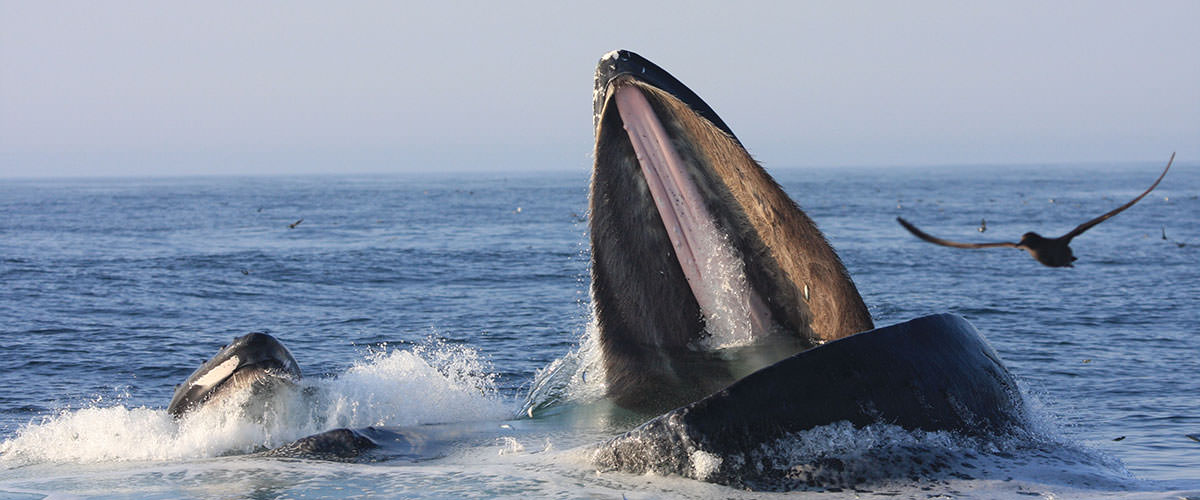
Click on individual links below to learn more about the immediate science needs for critical management issues. For a full list of management issues and science needs, please review the SBNMS Management Plan. To contact us about the science needs described below, contact the Sanctuary Research Coordinators.
-
Acoustic Impacts to Resources
Increasing levels of human activity in coastal waters are accompanied by increasing levels of anthropogenic underwater sound. Many marine animals, including mammals, fish and invertebrates, use sound to communicate, navigate, feed and avoid predators, among other critical life functions. Impacts to resources in Stellwagen Bank National Marine Sanctuary (Sanctuary) due to underwater noise warrant attention and research. (Updated 10/27/2014)
-
Conservation of Biodiversity
Understanding how key fish and invertebrate species, seafloor communities, and associated habitats respond to a range of human impacts is critical for assessing compatible human uses within the boundaries of Stellwagen Bank National Marine Sanctuary (SBNMS or Sanctuary) and meeting program goals focused on resource protection. (Updated 11/6/2014)
-
Fishing Impacts to Maritime Heritage Resources
Maritime heritage resources in Stellwagen Bank National Marine Sanctuary (SBNMS or Sanctuary) are being negatively impacted by traditional fishing activities. (Updated 10/31/2014)
-
Marine Debris
Marine debris, specifically derelict fishing gear, is a systemic problem with chronic impacts in the Stellwagen Bank National Marine Sanctuary (Sanctuary) and the Gulf of Maine. The problem impacts NOAA and the public by degrading marine resources in the sanctuary including the possible entanglement of endangered and protected marine mammals. A better understanding of the extent of the threat of marine debris, especially derelict fishing gear, and the impacts it has on the natural and historical resources of the Sanctuary is needed for effective management. (Updated 10/29/2014)
-
Marine Mammal Mortality and Injury
Mortality and serious injury to endangered whales occurs where ever whales co-occur with ships and commercial fishing. This includes the majority of national marine sanctuaries and is priority issue within the Stellwagen Bank National Marine Sanctuary (SBNMS or Sanctuary). (Updated 11/6/2014)
-
Marine Zoning: Research Area
Without a designated reference area, managers and the public have no idea what the integrity is of a natural, biological community in the Stellwagen Bank National Marine Sanctuary (Sanctuary), as specified by the National Marine Sanctuaries Act, or what the restoration targets for the Sanctuary should be. (Updated 11/6/2014)
-
Seabird Foraging, Habitat Use & Vulnerability to Anthropogenic Activities
Seabirds are top predators in the Stellwagen Bank National Marine Sanctuary (Sanctuary), yet little is known about their movements, foraging strategies and needs, or risks from anthropogenic activities. For example, little is known about seabird food habits and how animals might be impacted by changes in forage species as a result of changing ocean conditions or commercial removal. (Updated 11/6/2014)
-
Socioeconomics and the Human Dimension
Human activities clearly influence the quantity and quality of Stellwagen Bank National Marine Sanctuary (Sanctuary) resources, including water quality, habitat, living resources, and maritime archaeological resources. The National Marine Sanctuaries Act has as a purpose and policy to facilitate uses that are compatible with the primary objective of resource protection, but is silent on how compatibility should be determined. Determining compatibility is a data-intensive activity; consequently more data on the spatial distribution and intensity of human activities and how those activities change through time are necessary to assess the level of these impacts and whether they are compatible with resource protection. (Updated 11/6/2014)
-
Vessel Traffic
The quantity, types and movements of vessels in and around the Stellwagen Bank National Marine Sanctuary (SBNMS or Sanctuary) is unknown. These activities impact the Sanctuary in multiple ways including ship strikes to marine mammals, ocean noise, introduction of exotics, and pollutants. (Updated 11/6/2014)
-
Water Quality
Water quality is a key aspect of a national marine sanctuary. The Stellwagen Bank National Marine Sanctuary (SBNMS or Sanctuary) is an "urban" sanctuary in that it is adjacent to large population centers and used extensively for a variety of human activities, many of which have the potential to release pollutants into the environment. (Updated 11/6/2014)

